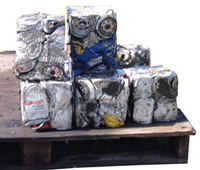Oil filter crushers can be a great investment. They help to greatly reduce disposal costs and turn the crushed filter and waste oil into potential revenue streams. They are also much more environmentally friendly than traditional disposal methods.
Buyers of oil filter crushers can choose from a variety of brands, capacities, sizes, power sources, build quality, and more. All these options can make selecting the most appropriate brand and model challenging.
The following guide was written to help oil filter crusher buyers understand what questions they should be asking and what features they should be considering.
Filter Type
Are you crushing car filters, truck filters, train filters, or something altogether different? Most oil filter crushers are designed for a specific purpose and have a loading chamber and a crushing force that aligns with that purpose.
An example would be an oil filter crusher that is designed for crushing locomotive filters. These filters can measure up to 36 inches in length and require a chamber large enough to hold anywhere from a single filter to multiple filters.
Likewise, there are oil filter crushers that are only used to crush automotive oil filters. Some of these models are small enough that they can be hung on a garage wall.
Load Capacity
How many oil filters are you crushing daily? Are you crushing them all at once or are you crushing them individually or in small batches throughout the day?
There are models in the market that are specifically designed to crush one filter at a time. Other crushers can crush multiple filters in the same or less time than the single unit models.
There’s no reason to purchase a high capacity crusher if you are crushing a handful of filters per day. However, you will be greatly frustrated if your crusher can’t keep up with your crushing needs. So you should definitely have an idea of your daily crushing demand, and if it’s high you may need to find a unit that allows for continuous operation.
Crushing Speed
Speed and capacity are related but not exactly the same. Whether you are crushing a single oil filter or large batch you probably don’t want to be waiting too long for the job to finish.
That brings up an issue with the single unit crushers. If you can only crush one oil filter at a time, the time spent loading and unloading per filter will be greater than models that can crush in batches.
Oil Collection
Where do you plan to collect the waste oil? Some units have a small holding tank that is self-contained. But, as these tanks have limited capacity you might end up spending a lot of time emptying it into a larger tank if you are processing more than a few filters per day. Other models are easily configured to drain oil into a larger holding tank such as a 55 gallon drum.
Available Space
Oil filter crushers come in all shapes and sizes. You will want to carefully check the available space in your shop to ensure that your crusher will fit. Also, make sure the space is adequate for draining the waste oil into a larger collection tank or drum if appropriate.
Electric Hydraulic vs. Pneumatic Hydraulic
Pneumatic Hydraulic models often market themselves as being a cheaper alternative to Electric Hydraulic models. And, if you are crushing only a few filters per day, that might make sense.
A downside to Pneumatic Hydraulic models is that they draw down the compressor tank which may interrupt the operation of other shop tools. They also force the compressor to run more often and often fail to deliver a consistent crush.
Electric Hydraulic models have the advantage of being self-contained, IE not requiring an additional power source, and they don’t require additional airlines, regulators, lubricators, and condensation filters.
With Electric Hydraulic units the machine shuts off when the cycle is complete. With pneumatic models the compressor continues to run in order to restore required pressure. Compressing air can be expensive because crushing requires large amounts of compressed air. Crushing can also reduce compressor life.
Safety
An oil filter crusher should have zero pinch points. You can check to see if the unit meets OSHA safety requirements and has features such as Hands Free Operation and Automatic Shutoff.
Key Features to Consider
Cycle Time
Cavity Size
Electrical Voltage/Amps
Crushing Force
Overall Height
Overall Width
Overall Depth
Shipping Weight

